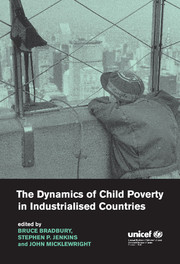Book contents
- Frontmatter
- Contents
- List of figures
- List of tables
- Notes on the contributors
- Acknowledgements
- 1 Beyond the snapshot: a dynamic view of child poverty
- Part I Issues and cross-national evidence
- Part II Topics in child poverty dynamics
- 5 Income mobility and exits from poverty of American children
- 6 Child poverty in Germany: trends and persistence
- 7 Poverty among British children: chronic or transitory?
- 8 Child income poverty and deprivation dynamics in Ireland
- 9 Young people leaving home: the impact on poverty in Spain
- 10 Are children being left behind in the transition in Hungary?
- 11 Mobility and poverty dynamics among Russian children
- Summary and policy conclusions
- Index of authors
- Index by subject
7 - Poverty among British children: chronic or transitory?
Published online by Cambridge University Press: 02 December 2009
- Frontmatter
- Contents
- List of figures
- List of tables
- Notes on the contributors
- Acknowledgements
- 1 Beyond the snapshot: a dynamic view of child poverty
- Part I Issues and cross-national evidence
- Part II Topics in child poverty dynamics
- 5 Income mobility and exits from poverty of American children
- 6 Child poverty in Germany: trends and persistence
- 7 Poverty among British children: chronic or transitory?
- 8 Child income poverty and deprivation dynamics in Ireland
- 9 Young people leaving home: the impact on poverty in Spain
- 10 Are children being left behind in the transition in Hungary?
- 11 Mobility and poverty dynamics among Russian children
- Summary and policy conclusions
- Index of authors
- Index by subject
Summary
Child poverty in Britain: a topical issue
Concern about child poverty in Britain has grown significantly and is currently a topic of hot policy interest. According to the Chancellor of the Exchequer, ‘child poverty is a scar on the soul of Britain’ (Brown 1999), and the Prime Minister has spoken of plans to end child poverty within twenty years (Blair 1999). Government programmes are now being explicitly directed at improving children's welfare (HM Treasury 1999, UK 1999). This new concern is based on evidence from official statistics and other studies which have revealed an increase in the incidence of low income among children (Department of Social Security 1998 and 1999, Gregg et al. 1999) and increases in their poverty relative to children in other countries (chapter 3, Bradbury and Jäntti 1999, Bradshaw 1997a). This evidence, reviewed later, is based on a series of snapshots of the distribution of income at a point in time. In this chapter we supplement the standard picture with longitudinal perspectives, in particular examining the extent to which child poverty in Britain is chronic rather than transitory in nature.
To place our research in context, we begin with an overview of long-term child poverty trends since the 1960s using data from a variety of repeated cross-section studies and evidence from cross-national research. We then concentrate our analysis on evidence about child poverty dynamics over a six-year period (1991–6) using panel data from the first six waves of the British Household Panel Survey (BHPS).
- Type
- Chapter
- Information
- The Dynamics of Child Poverty in Industrialised Countries , pp. 174 - 195Publisher: Cambridge University PressPrint publication year: 2001
- 17
- Cited by

